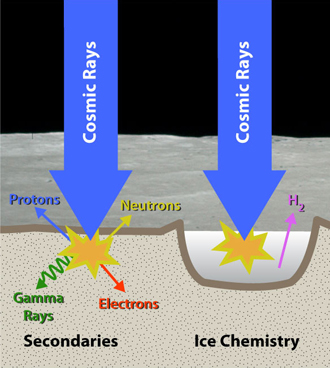Science
Scientists have used CRaTER data to understand how cosmic rays affect the Moon in a number of ways. Below, we describe three projects that are underway.
When cosmic rays hit atoms in the Moon, they can knock protons out of the atoms. Some of these protons fly back into space where CRaTER can detect them. If more cosmic rays hit the Moon, CRaTER detects more protons coming from the Moon. Scientists are currently making maps of the Moon using these protons.
Other scientists are using information from CRaTER to make predictions. Some craters on the Moon never receive any sunlight. These dark craters likely have water-ice within them. Data from CRaTER suggests that, over long times, cosmic rays will chemically affect the water. The scientists are working to see how this affects our understanding of ice on the Moon.
Scientists are also working on a third project. Cosmic rays can penetrate meters into the Moon's soil. When they do, they create an electric field beneath the Moon's surface. A strong electric field could cause lunar dust to float above the surface. Scientists are using computer models and data to estimate the electric field's strength and possible effects.
 |
“Science is cool, but it needs help to work. Go to the Engineering section to see how important designing and testing CRaTER were.” |

